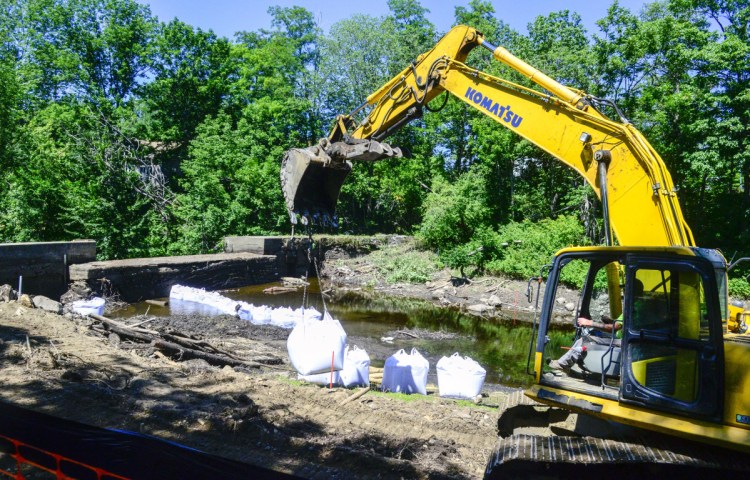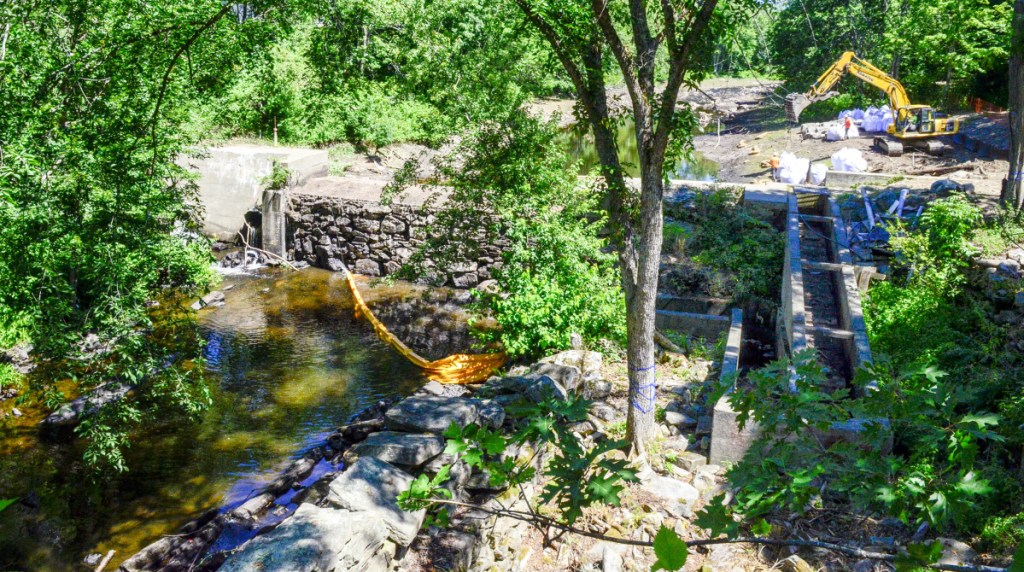WHITEFIELD — Work began Thursday to remove a roughly 200-year-old dam in the upper Sheepscot River to improve fish passage while providing the town of Whitefield with a more reliable source of water to fight fires.
The removal of the Coopers Mills dam – located roughly a dozen miles east of the State House in Augusta – is part of a three-year, roughly $2 million campaign to improve fish passage in a river within the heart of midcoast Maine that is home to Atlantic salmon, sturgeon, alewives and other sea-run fish. Yet the projects also aim to preserve some of the history surrounding historic dams and mills while enhancing public access to sites that once served important roles in the economies of local communities.
“For each of these projects, there will be a strong package of community benefits,” said Andrew Goode, vice president of U.S. operations for the Atlantic Salmon Federation, one of six conservation groups and government agencies working with local communities on the projects. And on the environmental side, Goode said, “there’s no one fish species that benefits. It’s really benefiting all fish.”
The Coopers Mills project is the latest in a string of river restoration efforts in Maine, ranging from the removal of small headwalls that impede fish migration, to the massive dam removal projects on the Penobscot and Kennebec rivers.
First laid down in the early 1800s, the 185-foot-long and nearly 20-foot-tall Coopers Mills dam was once integral to the operations of several mills operating there. The dam created a roughly 500-acre impoundment used both for recreation and as a source of water for firefighting tanker trucks that could tap in just upriver of the dam. But a sizable breach at the bottom of the dam, combined with a pattern of summertime droughts, means the water level in the impoundment now drops below the intake valve and well below levels needed to operate a fishway built in the 1950s.
Facing repair costs approaching $500,000, a special committee formed to decide the fate of the dam voted to recommend partnering with the Atlantic Salmon Federation and other groups to remove the deteriorating structure. The majority of residents at a 2016 town meeting agreed, and the Whitefield Board of Selectmen voted 5-0 to move forward with the project.
In addition to the Atlantic Salmon Federation, the list of project partners includes The Nature Conservancy, Midcoast Conservancy, the National Oceanic and Atmospheric Administration, the U.S. Fish and Wildlife Service and the Maine Department of Marine Resources.
When the project is done in early fall, much of the dam will have been demolished to allow the Sheepscot to flow more naturally through the village of Coopers Mills for the first time in two centuries. The remaining stone walls of the long-gone mill buildings will be stabilized and preserved, while the area around it will feature grass, benches and interpretive signs about the site’s history.
Important to town officials, crews will also install two new hydrants tapping water well below seasonal levels, with access points closer to the road to ensure firefighters can draw water at the site even during dry spells.
“It’s a beautiful little pond behind the dam and a nice waterfall,” said Selectman Tony Marple, describing the more than 40-foot spillway on the structure. “But the dam needed some action one way or another. And the Atlantic Salmon Federation provided funds to maintain the site over the long term” while offer improved public access.
On Thursday, work crews and fisheries biologists were in Coopers Mills to begin the dam removal.
An excavator removed from the river bank large sections of trees and timber beams believed to have served as the foundation or support for a road that predated the 200-year-old dam. Crews in chest-waders standing in the river helped guide the excavator as it lined up massive sacks of dirt that will be used to divert the river water to one side so dam deconstruction can take place on the other side. The dam could be breached next week.
Meandering nearly 60 miles from its headwaters near Freedom to where it flows into the Atlantic in Georgetown, the Sheepscot River is one of the few waterways in Maine that still support all of the sea-run or anadromous fish species that spend part of their lives in both freshwater and saltwater environments. Several of these species – including Atlantic salmon, shortnose sturgeon and Atlantic sturgeon – are federally protected. But the Sheepscot has also historically supported a sizable run of alewives, or river herring, that are a major part of the food chain for fish, birds and mammals.
“This project is important for all 12 species of sea-run fish and will strengthen the sustainability of the commercial alewife and elver fisheries,” Patrick Keliher, commissioner of the Maine Department of Marine Resources, said in a prepared statement. “As fish populations rebound, the benefits will expand to all life along the river corridor and into the Gulf of Maine, where groundfish populations and coastal mammals depended on migratory fish as part of their diet.”
Coopers Mills is one of just two remaining dams on the Sheepscot, with the other located at Head Tide in Alna about 13 miles downriver.
Next year, the group will turn its attention to removing a substantial section of the 100-year-old Head Tide dam to allow for upstream and downstream fish passage while respecting a deed covenant that prohibits the dam’s complete removal. And in 2020, the organizations plan to build a new fish passage system at Branch Pond Mill Dam in China. An additional proposal to allow alewives into Sheepscot Pond was dropped, however, in the face of significant pushback from local residents concerned that the alewives would harm the existing recreational fishery in the pond.
All told, the three-year project carries a price tag of about $2 million paid for with private donations and government grants.
“So $2 million sounds like a lot of money, but it is opening up really the whole stem of the river” to fish passage, said Jeremy Bell, river and coastal restoration director for The Nature Conservancy in Maine.
Kevin Miller can be contacted at 791-6312 or at:
Twitter: KevinMillerPPH
Send questions/comments to the editors.






Success. Please wait for the page to reload. If the page does not reload within 5 seconds, please refresh the page.
Enter your email and password to access comments.
Hi, to comment on stories you must . This profile is in addition to your subscription and website login.
Already have a commenting profile? .
Invalid username/password.
Please check your email to confirm and complete your registration.
Only subscribers are eligible to post comments. Please subscribe or login first for digital access. Here’s why.
Use the form below to reset your password. When you've submitted your account email, we will send an email with a reset code.